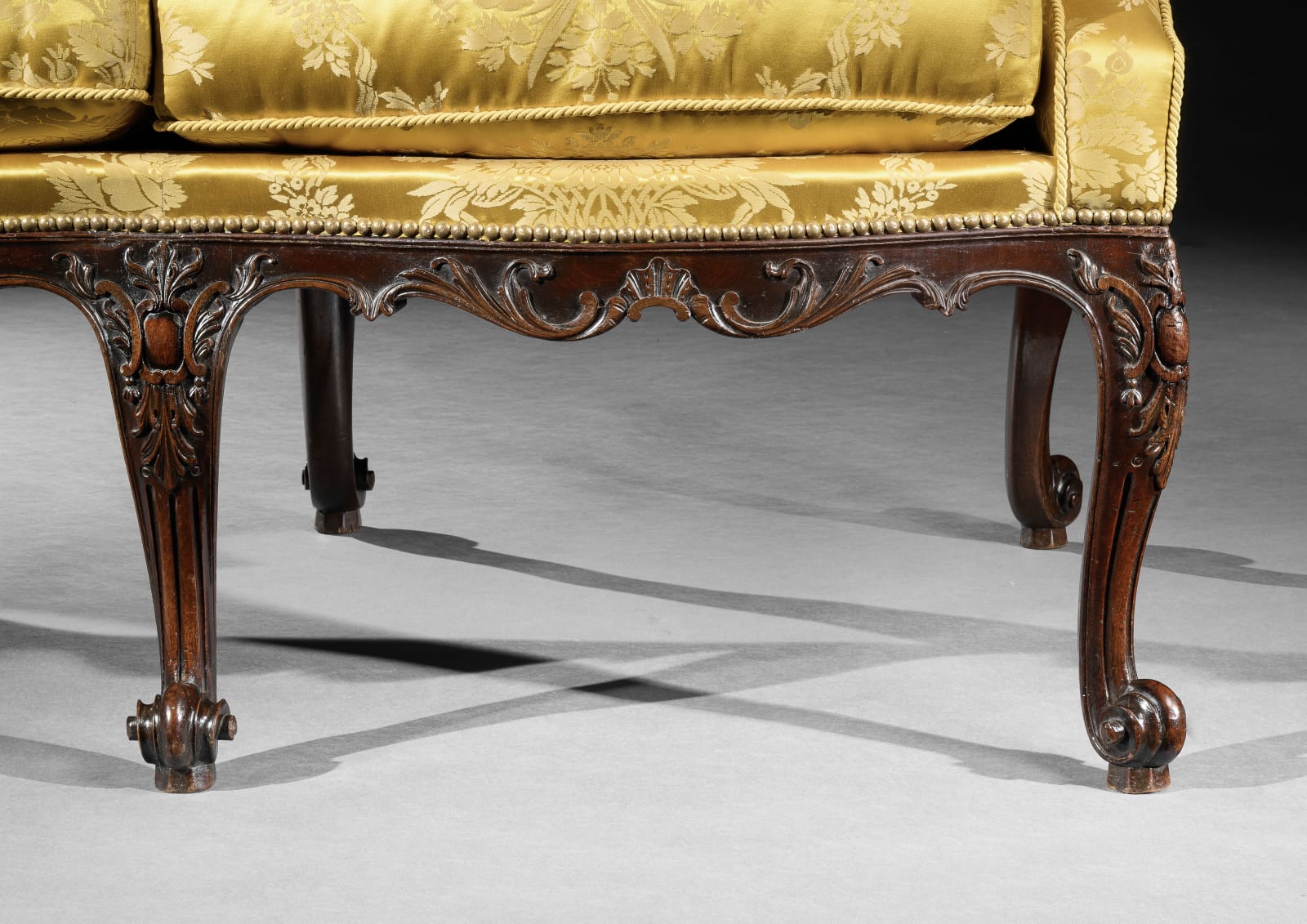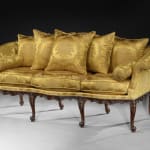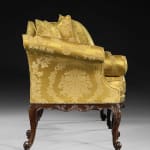Seating
A GEORGE II MAHOGANY SETTEE ATTRIBUTED TO PAUL SAUNDERS
W: 84.25" / 214cm
D: 33.5" / 85m
Further images
Provenance
Private Collection: London, UKLiterature
Cator, C. ‘Works of Art from Longleat’, Christie’s International Magazine (May/June 2002), pp. 69-78
Christie’s, Furniture, Silver and Porcelain from Longleat (June 2002), lots 338, 340
Coleridge, A. Chippendale Furniture (London, 1968), fig. 378-9
Coleridge, A. ‘Some Mid-Georgian Cabinet-Makers at Holkham’, Apollo, February 1964, pp. 122-8
Cornforth, John, ‘Holkham Hall, Norfolk – IV’, Country Life (14th February 1980) p. 431, fig. 14
Goodman, Sharon. ‘The 9th Earl of Lincoln (1720-1794) and the refurbishment of Exchequer House, 10 Downing Street’, The British Art Journal, Vol. 18, No. 3, Winter 2017, pp. 3-7
Moss Harris & Sons, The English Chair (London, 1946), p. 123, pl. LI
The cabochon enclosed by c-scrolls is characteristic of a large proportion of the seat furniture associated with the workshop of Paul Saunders. It appears on the set of ‘12 chairs, mahog. frames / Gilt’ and ‘10 Elbow / chairs with carved and gilt / frames’ supplied in 1757 to the 1st Earl of Leicester for Holkham Hall, for which ‘Mr. Saunders’ on 11th June charged £39. 10s. 3d. and £41. 18s., and notably on the ‘2 large sophas’ in the Gallery, which he supplied for £74. 4d.[1]
The same leg pattern appears on the suite of at least eight armchairs and two settees supplied to the 3rd Viscount Weymouth for Longleat, almost certainly included in the unspecified payments to Saunders of £556. 15s. in November 1757 and £300 in November 1759 recorded in the viscount’s Drummonds account.[2] These likely also covered the library table, en suite to the seat furniture, which is likewise carved with cabochons between c-scrolls.
The motif is even represented on the famous suite of parcel-gilt seat furniture supplied to Grimsthorpe Castle. Elements of this remain at the house, but some dispersed articles have been in the collections of Irwin Untermyer and Ann and Gordon Getty and have been extensively documented.[3]
The triple fluting of the legs and the scrolled toes practically confirm Saunders’ authorship, being features of the above-mentioned suites and others supplied to Holkham and Lowther Castle.[4] The shaped apron on serpentine rails carved with a central motif – often a wheatsheaf or shell – flanked by stylised acanthus leaf flourishes is likewise a feature of the Saunders group.[5]
A settee with identical carved decoration sold Christie’s, Jasper Conran: The Collection Part I, 14 September 2021, lot 176, GBP 93,750. A pair of chairs with the same carving, formerly in the collection of Sir Martyn Beckett, Bt., M.C., sold Sotheby’s, London, 18 November 2008, lot 348, GBP 94,850 and again Sotheby’s, New York, 16 October 2009, lot 135, USD 134,500.
[1] A. Coleridge, ‘Some Mid-Georgian Cabinet-Makers at Holkham’, Apollo, February 1964, pp. 122-8; J. Cornforth, Early Georgian Interiors (London, 2004), fig. 453; A. Coleridge, Chippendale Furniture (London, 1968), fig. 379
[2] Christie’s, Furniture, Silver and Porcelain from Longleat (June 2002), lots 338, 340
[3] Christie’s, New York, The Ann & Gordon Getty Collection: Volume 3, 22 Oct 2022, lot 380, USD 201,600; Yvonne Hackenbroch, English Furniture – The Irwin Untermyer Collection (1958), pl. 116, fig. 143
[4] Coleridge, Apollo, 1964, pp. 122-8
[5] Christie’s, London, 27 Nov 2003, lot 100, GBP 128,450 and Christie’s, New York, 30 Nov 2012, lot 380, USD 236,500, c.f. H. Cescinsky, English Furniture of the Eighteenth Century (London, 1911), vol. II, p. 91, fig. 89 (an armchair from the suite; with C. J. Charles, Esq.) and M. Jourdain and F. Rose, English Furniture, The Georgian Period (1750-1830) (London, 1953), p. 71, fig. 30 (an armchair from the suite with Phillips of Hitchin); Sotheby’s, London, 18 November 2008, lot 328 and New York, 16 October 2009, lot 96





